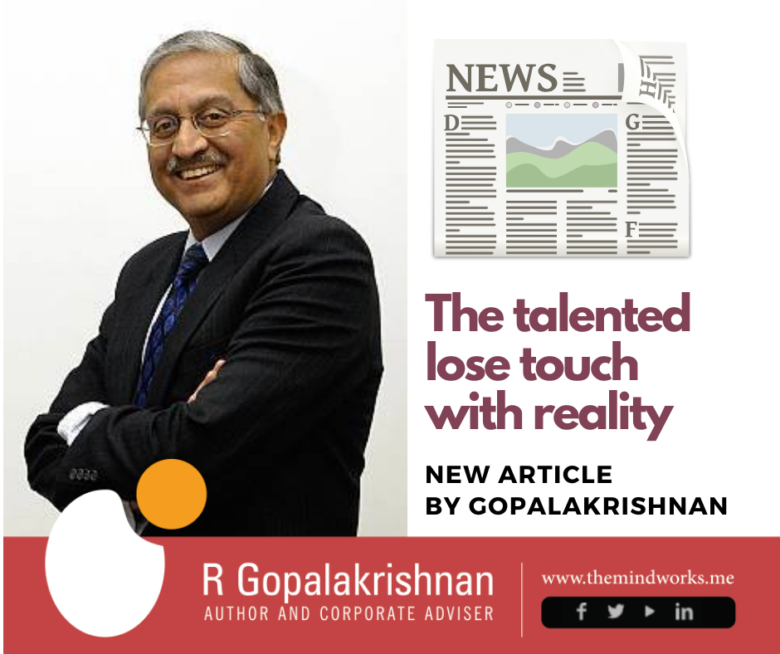3rd Feb 2017, BUSINESS STANDARD
By R Gopalakrishnan, Author and Corporate Advisor
“….Men of business are not often at home in the world of ideas; it was Jamsetji’s distinction that he lived in both worlds, the world of ideas and the world of action. It was because Jamsetji Tata lived in the world of ideas and had imagination that he played the role of pioneer in India….”
JRD Tata
What a fabulous response I got to my last column about how a setback fired the creativity of an unknown Kamal Shah who set up India’s largest dialysis chain (BS, 6th Jan 2017)! Just ten days later, the BBC published a story entitled “How disaster inspired a multi-billion dollar business”. It is a story about Canadian Serge Godin, whose family sawmill business got destroyed by fire, and how Godin grew up to set up a multi-billion dollar CGI, a computer business (http://www.bbc.co.uk/news/business-38594679).
I have been provoked to think more about the curiosity word, which is the “engine of intellectual achievement and it is what drives us to keep learning and pushing forward,” according to science writer Annie Murphy Paul (Origins: how the nine months before our birth shape the rest of our lives). In past columns I had likened the transformation of a fetus into a baby with how a concept in the brain transforms into an idea. No sooner the child is born, it displays intense curiosity about just about everything. In the same way, every articulated idea gets nurtured and modified by curiosity. Curiosity is the essential hormone for creativity and innovation.
We are not sure why we say ‘curiosity killed the cat?’ In 1588 British playwright Ben Jonson used the expression, ‘Care will kill a cat.’ In his Much Ado about Nothing, William Shakespeare wrote, “What, courage man! What though care killed a cat, up-tails all, and a pox on the hangman.’ By 1873, the expression morphed into ‘Curiosity killed the cat’.
If the truth be told, curiosity is the preserve of all forms of genius. It is curiosity that accounts for the progress of mankind. We should recall what was written by Einstein, “I have no special talents, I am only passionately curious.”
“Curiosity is one of those personality traits that gets short scientific shrift,” according to a 2010 article in Wired magazine. Author, Jonah Lerner, stated that raw intelligence has been researched to death, but our curiosity about the world remains a mystery. In a seminal paper published in 1994, George Loewenstein of Carnegie Melon University argued that curiosity comes alive when “we feel a gap between what we know and what we want to know.” What a marvelous insight, so simple, yet so powerful! It is a different way of saying that everything that humankind knows so far (undoubtedly an impressive amount) appears like a set of little dots on an enormous, white surface of ignorance. The statement makes knowledge humble.
So if you know absolutely nothing about a subject, you have no curiosity. Equally if you feel you know everything about a subject, then your curiosity about knowing more becomes zero. In between knowing nothing and everything, lies the point where you know a little but do not believe that you know too much. If knowledge is on the X-axis and curiosity on the Y-axis, then curiosity peaks in an inverted U-shape. This was scientifically established by the Colin Camerer laboratory experiments at Caltech.
Annie Murphy Paul, a science writer, suggests three practical ways to stimulate curiosity. First, teachers should spend time asking the right question, one that opens up an information gap in the student’s mind. An alumnus of London School of Economics, BK Nehru apologetically told his former teacher, Harold Lasky, that, going by Nehru’s civil service experience, Lasky’s ideas did not work in India. Lasky responded, “But I gave you no answers. I was merely teaching you how to think.” Second, be aware that you know only a little bit because then you want to know more and your curiosity pump gets primed. Third, communicate with others, because language and communication are the tools of natural learners.
Business managers are essentially men and women of ideas and curiosity; business is not far from the world of ideas unless you assume that to be so. Commerce and business are mere manifestations of the dreams and passions of people and organizations. Having served Tata for long years, I have been intrigued by what made the founder, Jamsetji Tata, pursue all that he pursued. Was it raw passion or inspiration from ideas, or both?
Listening to a speech by influential British author and philosopher, Thomas Carlyle, “The nation that has steel will have gold,” sent Jamsetji on a voyage of curiosity and the establishment of a steel business. Long sea voyages and relaxed conversations promoted curiosity. A chance meeting with Swami Vivekananda on a boat ride from Yokohama to San Francisco in 1893 fired Jamsetji’s mind with an idea that later manifested as the Indian Institute of Science. The legendary JRD Tata, in his foreword to Frank Harris’s biography on JN Tata in June 1957 wrote, “….Men of business are not often at home in the world of ideas; it was Jamsetji’s distinction that he lived in both worlds, the world of ideas and the world of action. It was because Jamsetji Tata lived in the world of ideas and had imagination that he played the role of pioneer in India….”
Jamsetji’s zest for life and humanity kept him curious.

